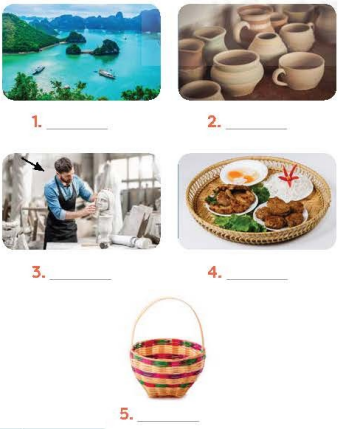Fill in the blank with only ONE word
There are many embroidery villages in Vietnam, but Quat Dong village in Hanoi is widely known for its high-quality products. Located next to a national highway, the Quat Dong embroidery village is one of the 200 most well-known traditional
villages in Vietnam.
Embroidery has been developing around here since the 17th century; local skilled
were chosen to make sophisticated embroidered costumes for the Vietnamese King, Queen and other Royal family members before Vietnam became a socialist republic country.
The first man who taught the local people how to
was Dr. Le Cong Hanh, who lived during the Le dynasty. He learned how to embroider while on a trip to China as an envoy, and taught the villagers of Quat Dong upon his return. Although these skills eventually spread across the country, the Quat Dong’s artisans’ creations are still the most appreciated. In order to create beautiful embroideries, an artisan must be
, meticulous and have an eye for design, along with clever hands. Nowadays, Quat Dong products may range from clothes, bags, pillow cases, to paintings and decorations, which are
to many countries.
There are many embroidery villages in Vietnam, but Quat Dong village in Hanoi is widely known for its high-quality products. Located next to a national highway, the Quat Dong embroidery village is one of the 200 most well-known traditional
villages in Vietnam.
Embroidery has been developing around here since the 17th century; local skilled
were chosen to make sophisticated embroidered costumes for the Vietnamese King, Queen and other Royal family members before Vietnam became a socialist republic country.
The first man who taught the local people how to
was Dr. Le Cong Hanh, who lived during the Le dynasty. He learned how to embroider while on a trip to China as an envoy, and taught the villagers of Quat Dong upon his return. Although these skills eventually spread across the country, the Quat Dong’s artisans’ creations are still the most appreciated. In order to create beautiful embroideries, an artisan must be
, meticulous and have an eye for design, along with clever hands. Nowadays, Quat Dong products may range from clothes, bags, pillow cases, to paintings and decorations, which are
to many countries.
Tạm dịch:
Có rất nhiều làng thêu ở Việt Nam, nhưng làng Quất Đông ở Hà Nội được biết đến rộng rãi với những sản phẩm chất lượng cao. Nằm cạnh quốc lộ, làng thêu Quất Đồng là một trong 200 làng nghề thủ công truyền thống nổi tiếng nhất Việt Nam.
Nghề thêu đã được phát triển ở đây từ thế kỷ 17; Các nghệ nhân lành nghề địa phương đã được chọn để làm trang phục thêu tinh xảo cho Vua, Hoàng hậu và các thành viên gia đình Hoàng gia khác trước khi Việt Nam trở thành một nước cộng hòa xã hội chủ nghĩa.
Người đàn ông đầu tiên dạy người dân địa phương cách thêu là bác sĩ Lê Công Hạnh, người sống trong triều đại nhà Lê. Ông học cách thêu thùa trong một chuyến đi đến Trung Quốc với tư cách là một đặc phái viên, và dạy cho dân làng Quấtt Đông khi trở về. Mặc dù những kỹ năng này cuối cùng đã lan rộng khắp đất nước, nhưng những sáng tạo của nghệ nhân Quất Đông thường vẫn được đánh giá cao nhất. Để tạo ra những bức thêu đẹp, một nghệ nhân phải kiên nhẫn, tỉ mỉ và có con mắt thiết kế, cùng với đôi bàn tay khéo léo. Ngày nay, các sản phẩm Quất Đông rất đa dạng có thể kể đến là quần áo, túi xách, vỏ gối, đến tranh vẽ và đồ trang trí, được xuất khẩu sang nhiều nước.

Các bài tập cùng chuyên đề
2. Write a word or phrase in the box under the correct picture.
(Viết một từ hoặc cụm từ vào ô bên dưới bức tranh đúng.)
|
tourist attraction speciality food handicraft pottery artisan |

3. Fill in each blank with a word or phrase from the box.
(Điền vào mỗi chỗ trống một từ hoặc cụm từ trong khung.)
|
artisans handicrafts garbage collector electrician speciality food |
1. Skilled local _______ made these beautiful flower vases.
2. The electrical wires in our neighbourhood broke down yesterday, so we had to call a(n) _______.
3. Bun cha, pho, and hu tieu are examples of famous Vietnamese _______.
4. The _______ in our street usually comes at 6 p.m. to take the rubbish away.
5. Tourists to Hoi An usually buy traditional _______ such as lanterns as souvenirs.
2. Circle the correct word or phrase to complete each sentence.
(Khoanh tròn từ hoặc cụm từ đúng để hoàn thành mỗi câu.)
1. The villagers (preserve / shorten) their traditional weaving techniques.
2. Com Lang Vong has a special (fragrance / function), so it is very popular.
3. Our (firefighters / police officers) help keep law and order in our community.
4. Spring rolls are the (speciality food / fast food) I like best.
5. My home town is famous for (handicrafts / objects), such as paper fans and lanterns.
1. Solve the crossword puzzle.
(Giải ô chữ.)
Across:
1. pots, dishes, etc. made with clay
2. a product which is made by hand
3. a place where children play
4. the people living in a particular area
5. the place where people see objects from the past
Down:
6. a place where people watch sports
7. the buildings, equipment, and services provided for a particular purpose
8. an area outside the centre of a city
3. Choose A, B, C, or D to complete each sentence.
(Chọn A, B, C hoặc D để hoàn thành mỗi câu.)
1. There is a market in our area where you can buy all kinds of handmade products. It may be the biggest _____ market in our country.
A. thing
B. product
C. handicraft
D. selling
2. The Tower of London is one of the top _____ in the UK.
A. tourist places
B. tourism places
C. guided tours
D. tourist attractions
3. This restaurant serves _____ of Italy such as lasagna and risotto.
A. speciality dish
B. speciality food
C. special dish
D. special things
4. This beautiful headband _____ us of our holiday in Greece.
A. tells
B. shares
C. reminds
D. makes
5. The condo is so small and there are not enough _____ for families with young children.
A. facilities
B. equipment
C. tools
D. space
6. They didn’t like the noisy city centre, so they moved to live in a(n) _____ of London.
A. outskirt
B. neighbourhood
C. area
D. suburb
Match the steps of making silk threads with its suitable meanings.
Read the passage, and choose the correct answer A, B, C or D for each question.
Recently, we made a trip to visit Dong Ho village with a desire to meet the old artisan - Nguyen Huu Sam. Just when we arrived at the dyke in the village and talked with the villagers about the artisan, they immediately told us about him.
The old house owned by the artisan is situated in a long alley of the village. On the walls: the house there are many folk paintings in different genres, from daily life paintings to landscape paintings shown in a set of “four seasons”.
Mr. Sam told us about his past. When he was three years old, he was instructed in the craft of making Dong Ho paintings by his rather. At five, he could help his father apply the Dong Ho raintings, and learn how to print the paper with proper colours.
At seven, he was able to draw with a pen and make the most difficult samples. Years went by and the soul of Dong Ho folk raintings has kept seashell powder paint to the poonah-paper.
In the 1940s, this craft flourished. At that time, he was assigned by his parents to take the paintings to the market for sale. Mr. Sam said that 17 families in the village have been engaged in making Dong Ho paintings.
Artisan Sam has always been devoted to the making of Dong Ho paintings and has waited for opportunities to restore this traditional craft. In 1967, when the local authorities assigned him to restore the traditional genre of Dong Ho folk paintings, he gathered 50 villagers with professional skills and collected hundreds of woodblocks to establish the Dong Ho Painting Cooperative. Thanks to his efforts, such famous paintings as "Rat’s wedding”, “Rooster”, “Scene of jealousy” and “Writing verses about precious flowers” have been revived. Dong Ho paintings have been available in many parts of the world such as Japan, France, Germany, Singapore and the United States.
Give the correct form of the word in the brackets.
The second collection was more decorative, inspired by ___________ and pattern. (embroider)






